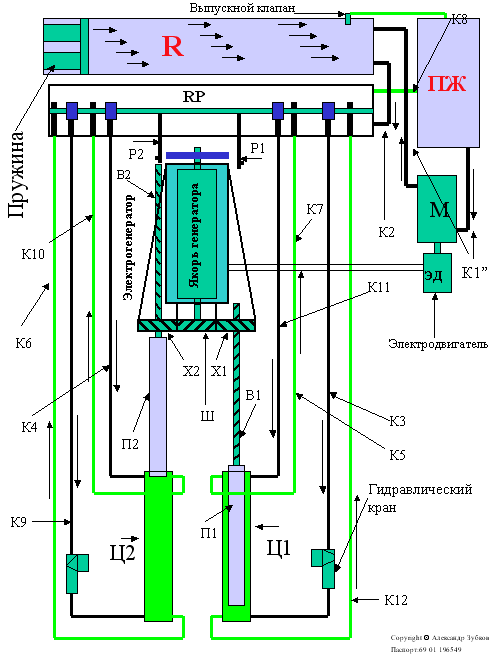| section Home
Production, Amateur Radio amateur Model aircraft, rocket- Useful, entertaining |
Stealth master
Electronics Physics Technologies invention |
space Mystery
Earth Mysteries Secrets of the Ocean Stealth section Map |
|
| Use of material is permitted for reference (for websites - hyperlinks) | |||
Navigation: => |
Home / Invention / New types of engines / |
|
UNUSUAL FOR HYDRAULIC Electricity generators
Overcoming resistance to electromagnetic
by the force of pressure
Publication Author: Zubkov Alexander
Watching the work of the hydraulic pump with hand drive my attention was drawn to the fact that performed quite "big" work (forgive my ignorance of terminology) at low energy costs. So, I came up with the idea of creating a hydraulic drive for the electric generator (base: by the pressure force to overcome the resistance of the electromagnetic inverse).

closed circuit
Principle:
a liquid receiver (R) oil pump (M), electric (ED) through the channel (K1 ') is supplied fluid (hydraulic oil). When pumping fluid spring is compressed, thereby creating a volume of pressurized fluid. Fluid under pressure through a channel (K2) is supplied to the automatic distributor (RP) with the camshaft with cone-poluoborotnymi taps valves.
The circuit is ready to launch
Running:
In the automatic distributor (RP) simultaneously opens the intake valve of the hydraulic cylinder (Ts1) in the duct (K3), the inlet valve of the hydraulic cylinder (C2) in the channel (K4), the exhaust valve of the cylinder (Ts1) in the channel (K5) and an exhaust valve of the hydraulic cylinder (C2) in the channel (K6).
Act:
The piston (P1) of the cylinder (TS1) comes out of the cylinder (TS1) and puts forward shaft (B1).
Val (B1) advancing forward creates a circular rotation of the ratchet (X1) (ratchet principle whirligig design) and through the gear (W), the self-excited DC generator creates a circular rotation of the armature, the fluid from the cylinder (TS1), in free from a state of pressure channel (K7) enters the automatic dispenser and from there through the channel (K8) in the liquid receiver (RV).
A generator produces an electrical current, and supplies it to the motor (ED) buttered pump (M).
Oily pump (M) powered by an electric motor (ED) delivers fluid to the receiver (R).
The piston (P2) of the cylinder (C2) into the cylinder (C2) and drags the shaft (B2).
Val (B2) passing through the ratchet (X2) does not cause its rotation. The liquid from the cylinder (C2) in the free state of pressure through the channel (K6) is supplied to the automatic dispenser and from there through the channel (K8) in the liquid receiver (RV).
Val (B1) passing through the ratchet (X1), abuts the lever (P1) and carries a camshaft in position 2, comprising: simultaneously closes the inlet valve of the cylinder (Ts1) in the duct (K3), the exhaust valve of the cylinder (TS1) in channel (K7), the inlet valve of the cylinder (C2) in the channel (K4), the exhaust valve of the cylinder (C2) in the channel (K6) simultaneously opens the intake valve of the cylinder (C2) in the channel (K9), the exhaust valve of the cylinder (C2) in channel (k10), the inlet valve of the cylinder (TS1) a channel (K11), the exhaust valve of the cylinder (TS1) a channel (K12).
Action completed.
print version
Author: Alexander Zubkov
Passport: 69 01 196549
PS material is protected.
Publication date 23.09.2004gg




Comments
Commenting, keep in mind that the content and the tone of your messages can hurt the feelings of real people, show respect and tolerance to his interlocutors, even if you do not share their opinion, your behavior in terms of freedom of speech and anonymity offered by the Internet, is changing not only virtual, but real world. All comments are hidden from the index, spam control.